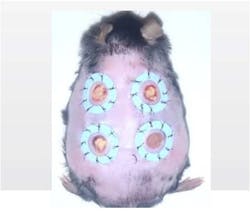| As part of a photodynamic-therapy (PDT) experiment using violet-LED light and a photosensitizing material, a mouse is given skin ulcers that are infected with MRSA. (Image: Tech-on!) |
As noted in Tech-On!, a research group at Osaka City University (Osaka, Japan) has treated skin ulcers infected with methicillin-resistant Staphylococcus aureus (MRSA) bacteria by combining two therapies: 1) photodynamic therapy (PDT) using light at a 410 nm wavelength from gallium nitride (GaN)-based LEDs, and 2) administering 5-aminolevulinic acid (ALA), a natural amino acid.1
An important advantage of the new technique is that it does not cause the emergence of resistant bacteria, in contrast to the use of antibiotics. The group is developing it in collaboration with SBI Pharmaceuticals (Tokyo, Japan), and is planning to conduct a preclinical test targeted at skin ulcers infected with MRSA.
In recent years, the emergence of bacteria resistant to antibacterial drugs has become a scourge, especially in hospitals; MRSA is a famous example. Skin ulcers infected with MRSA are more difficult to cure than those that are not, in some cases leading to death of the patient. Recently, MRSA resistant to the antibiotic vancomycin, which has up until now been effective in the treatment of MRSA, has emerged. As a result, treatments must be developed that do not rely on antibacterial drugs and do not generate new resistant bacteria.
PDT-produced reactive oxygen kills MRSA
In the experiment, the researchers created skin ulcers infected with MRSA on the back of a mouse. Next ALA, which produces photosensitivity in the mouse, was administered systemically. The ulcers were then irradiated with light from the blue-violet LEDs, causing the bacteria to be annihilated through their interaction with reactive oxygen produced by the LED light and the photosensitive amino acid.
As a result, the MRSA bacteria were sterilized and ulcer healing was accelerated. In contrast, a control mouse treated with vancomycin but not PDT did not experience accelerated ulcer healing.
Source: http://techon.nikkeibp.co.jp/english/NEWS_EN/20140831/373440/
REFERENCE:
1. Kuniyuki Morimoto et al., PLOS ONE (2014); doi: 10.1371/journal.pone.0105173
